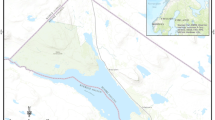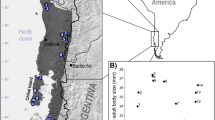Abstract
Environmental variation connected with seasonality is likely to affect the evolution of life-history strategies in ectotherms, but there is no consensus as to how important life-history traits like body size are influenced by environmental variation along seasonal gradients. We compared adult body size, skeletal growth, mean age, age at first reproduction and longevity among 11 common frog (Rana temporaria) populations sampled along a 1,600-km-long latitudinal gradient across Scandinavia. Mean age, age at first reproduction and longevity increased linearly with decreasing growth season length. Lifetime activity (i.e. the estimated number of active days during life-time) was highest at mid-latitudes and females had on average more active days throughout their lives than males. Variation in body size was due to differences in lifetime activity among populations—individuals (especially females) were largest where they had the longest cumulative activity period—as well as to differences between populations in skeletal growth rate as determined by skeletochronological analyses. Especially, males grew faster at intermediate latitudes. While life-history trait variation was strongly associated with latitude, the direction and shape of these relationships were sex- and trait-specific. These context-dependent relationships may be the result of life-history trade-offs enforced by differences in future reproductive opportunities and time constraints among the populations. Thus, seasonality appears to be an important environmental factor shaping life-history trait variation in common frogs.


Similar content being viewed by others
References
Adams DC, Church JO (2008) Amphibians do not follow Bergmann’s rule. Evolution 62:413–420
Adolph SC, Porter WP (1996) Growth, seasonality and lizard life histories: age and size at maturity. Oikos 77:267–278
Alexandersson H, Karlström K, Larsson-McCann S (1991) Temperature and precipitation in Sweden 1961–90. Reference normals. Swedish Meteorological and Hydrological Institute, Norrköping
Alho JS, Herczeg G, Merilä J (2008) Female-biased sex ratios in the subarctic common frogs. J Zool 275:57–63. doi:10.1111/j.1469-7998.2007.00409.x
Alho JS, Herczeg G, Söderman F, Laurila A, Jönsson KI, Merilä J (2010) Increasing melanism along a latitudinal gradient in a widespread amphibian: local adaptation, ontogenic or environmental plasticity? BMC Evol Biol 10:317. doi:10.1186/1471-2148-10-317
Alho JS, Herczeg G, Laugen AT, Räsänen K, Laurila A, Merilä J (2011) Allen’s rule revisited: quantitative genetics of extremity length in the common frog along a latitudinal gradient. J Evol Biol 24:59–70. doi:10.1111/j.1420-9101.2010.02141.x
Angilletta MJ Jr (2001) Thermal and physiological constraints on energy assimilation in a widespread lizard. Ecology 82:3044–3056. doi:10.1890/0012-9658(2001)082[3044:TAPCOE]2.0.CO;2
Angilletta MJ Jr (2009) Thermal adaptation. A theoretical and empirical synthesis. Oxford University Press, New York
Angilletta MJ Jr, Niewiarowski PH, Dunham AE, Leaché AD, Porter WP (2004a) Bergmann’s clines in ectotherms: illustrating a life-history perspective with Sceloporine lizards. Am Nat 164:E168–E183
Angilletta MJ Jr, Steury TD, Sears MW (2004b) Temperature, growth rate, and body size in ectotherms: fitting pieces of a life-history puzzle. Intergr Comp Biol 44:498–509. doi:10.1093/icb/44.6.498
Ashton KG (2002) Do amphibians follow the Bergmann’s rule? Can J Zool 80:708–716. doi:10.1139/z02-049
Ashton KG, Feldman CR (2003) Bergmann’s rule in nonavian reptiles: turtles follow it, lizards and snakes reverse it. Evolution 57:1151–1163. doi:10.1111/j.0014-3820.2003.tb00324.x
Atkinson D (1994) Temperature and organism size—a biological law for ectotherms? Adv Ecol Res 25:1–58. doi:10.1016/S0065-2504(08)60212-3
Beaupre SJ (1996) Field metabolic rate, water flux, and energy budgets of mottled rock rattlesnakes, Crotalus lepidus from two populations. Copeia 1996:319–329
Belk MC, Houston DD (2002) Bergmann’s rule in ectotherms: a test using freshwater fishes. Am Nat 160:803–808. doi:10.2307/3078861
Bergmann C (1847) Über die Verhärltnisse der Wärmeökonomie der Thiere zu ihrer Grösse. Göttinger Studien 3:595
Bernando J (1993) Determinants of maturation in animals. Trends Ecol Evol 8:166–173. doi:10.1016/0169-5347(93)90142-C
Blanckenhorn WU, Dermot M (2004) Bergmann and converse Bergmann latitudinal clines in arthropods: two ends of a continuum? Integr Comp Biol 44:413–424. doi:10.1093/icb/44.6.413
Brown JH, Gillooly JF, Allen AP, van Savage M, West GB (2004) Toward a metabolic theory of ecology. Ecology 85:1771–1789
Castanet J, Smirina EM (1990) Introduction to the skeletochronological method in amphibians and reptiles. Ann Sci Nat (Zool) Ser 13, 11:191–196
Castanet J, Meunier FS, de Ricqles A (1977) L’enregistrement de la croissance cyclique par le tissue asseux chez les vertebres poikilothermes donnees comparatives et essai de synthese. Bull Biol Fr Belg T 111:183–202
Charlesworth B (1994) Evolution in age-structured populations. Cambridge University Press, Cambridge
Crone RA, Bond CE (1976) Life history of coho salmon, Oncorhynchus kisutch, in Sashin Creek, south-eastern Alaska. United States National Oceanic and Atmospheric Administration Fishery Bulletin 74:897–923
Fog K, Schmedes A, de Lasson DR (1997) Nordens padder og krybdyr. Gad, Copenhagen
Geist V (1986) Bergmann’s rule is invalid. Can J Zool 65:1035–1038. doi:10.1139/z87-164
Haapanen A (1982) Breeding of the common frog (Rana temporaria L.). Ann Zool Fennici 19:75–79
Hemelaar ASM (1981) Age determination of male Bufo bufo (Amphibia, Anura) from the Netherlands, based on year rings in phalanges; Amphibia Reptilia 3/4:223–233
Hemelaar ASM, Vangelder JJ (1980) Annual growth rings in phalanges of Bufo bufo (Anura, Amphibia) from the Netherlands and their use for age determination; J Zool (Neth) 30:129–135
Hettyey A, Laurila A, Herczeg G, Jönsson KI, Kovács T, Merilä J (2005) Does testis weight decline towards the Subarctic? A case study on the common frog, Rana temporaria. Naturwissenschaften 92:188–192. doi:10.1007/s00114-005-0607-3
Jonsson B, L’Abée-Lund JH (1993) Latitudinal clines in life-history variables of anadromous brown trout in Europe. J Fish Biol 43:1–16. doi:10.1111/j.1095-8649.1993.tb01175.x
Jönsson KI, Herczeg G, O’Hara B, Söderman F, ter Schure AFH, Larsson P, Merilä J (2009) Sexual patterns of prebreeding energy reserves in the common frog Rana temporaria along a latitudinal gradient. Ecography 32:831–839. doi:10.1111/j.1600-0587.2009.05352.x
Karan D, Munjal AK, Gibert P, Moreteau B, Parkash R, David JR (1998) Latitudinal clines for morphometrical traits in Drosophila kikkawi: a study of natural populations from the Indian subcontinent. Genet Res 71:31–38
Karl I, Fischer K (2009) Altitudinal and environmental variation in lifespan in Copper butterfly Lycaena tityrus. Funct Ecol 23:1132–1138. doi:10.1111/j.1365-2435.2009.01607.x
Laugen AT, Laurila A, Merilä J (2003a) Latitudinal and temperature-dependent variation in embryonic development and growth in Rana temporaria. Oecologia 135:548–554. doi:10.1007/s00442-003-1229-0
Laugen AT, Laurila A, Räsänen K, Merilä J (2003b) Latitudinal countergradient variation in the common frog (Rana temporaria) development rates—evidence for local adaptation. J Evol Biol 16:996–1005. doi:10.1046/j.1420-9101.2003.00560.x
Laugen AT, Laurila A, Jönsson KI, Söderman F, Merilä J (2005) Do common frogs (Rana temporaria) follow Bergmann’s rule? Evol Ecol Res 7:717–731
Laurila A, Lindgren B, Laugen AT (2008) Antipredator defenses along a latitudinal gradient in Rana temporaria. Ecology 89:1399–1413. doi:10.1890/07-1521.1
Lindgren B, Laurila A (2005) Proximate causes of adaptive growth rates: growth efficiency variation among latitudinal populations of Rana temporaria. J Evol Biol 18:820–828. doi:10.1111/j.1420-9101.2004.00875.x
Lyapkov SM, Kornilova MB, Severtsov AS (2004a) Factors affecting reproductive success in Rana temporaria males. 1. Demographic and morphometric characteristics. Zool Zh 83:1375–1386
Lyapkov SM, Kornilova MB, Severtsov AS (2004b) Factors affecting reproductive success in Rana temporaria males. 2. Relationship between morphometric characteristics and reproductive success in males. Zool Zh 83:1448–1462
Miaud C, Guyétant R, Elmberg J (1999) Variation in life-history traits in the common frog Rana temporaria (Amphibia: Anura): a literature review and new data from the French Alps. J Zool Lond 249:61–73. doi:10.1111/j.1469-7998.1999.tb01060.x
Mousseau TA (1997) Ectotherms follow the converse to Bergmann’s rule. Evolution 51:630–632
Norry FM, Loeschcke V (2002) Longevity and resistance to cold-stress in cold-stress selected lines and their controls in Drosophila melanogaster. J Evol Biol 15:775–783
Rensch B (1938) Some problems of geographical variation and species formation. Proc Linn Soc Lond 150: 275–285
Roff DA (2002) Life history evolution. Sinauer, Sunderland, MA. doi:10.1046/j.1420-9101.2002.00438.x
Schemske DW, Mittelbach GC, Cornell HW, Sobel JM, Kaustuv R (2009) Is there a latitudinal gradient in the importance of biotic interactions? Annu Rev Ecol Evol Syst 40:245–269. doi:10.1146/annurev.ecolsys.39.110707.173430
Sears MW (2005) Resting metabolic expenditure as a potential source of variation in growth rates of the sagebrush lizard. Comp Biochem Physiol A 140:171–177. doi:10.1016/j.cbpb.2004.12.003
Smirina EM (1994) Age determination and longevity in amphibians. Gerontology 40:133–146
ter Schure AFH, Larsson P, Merilä J, Jönsson KI (2002) Latitudinal fractionation of polybrominated dipheyl ethers and polychlorinated biphenyls in frogs (Rana temporaria). Environ Sci Technol 36:5057–5061
Acknowledgments
We thank A.T. Laugen, K. Räsänen, M. Pahkala, S. Andersson, J. Elmberg, A. Järvinen, S. Karttunen, B. Lardner, J. Loman, G. Løe, G. Sahlén and R. Tramontano for help in field and laboratory and B. Rogell and J. Loehr for helpful comments on the manuscript. We also want to thank W. Blackenhorn and two anonymous reviewers for fruitful comments. The reported experiments comply with the current laws of Sweden and Finland concerning animal experimentation, and permission to collect frogs was received from the Ethical Committee for Animal Experiments in Uppsala County (C21/98). The Swedish Research Council (I.J., A.L., J.M,) and the Academy of Finland (A.L., J.M.) funded this research.
Conflict of interest
The authors declare they have no conflict of interest.
Author information
Authors and Affiliations
Corresponding author
Additional information
Communicated by Lin Schwarzkopf.
Rights and permissions
About this article
Cite this article
Hjernquist, M.B., Söderman, F., Jönsson, K.I. et al. Seasonality determines patterns of growth and age structure over a geographic gradient in an ectothermic vertebrate. Oecologia 170, 641–649 (2012). https://doi.org/10.1007/s00442-012-2338-4
Received:
Accepted:
Published:
Issue Date:
DOI: https://doi.org/10.1007/s00442-012-2338-4




